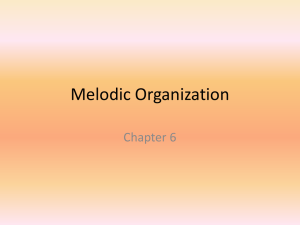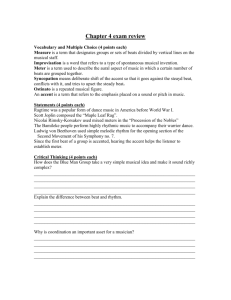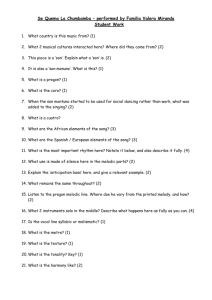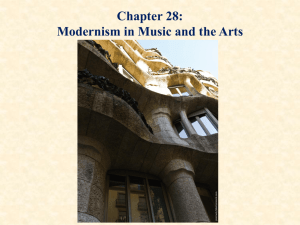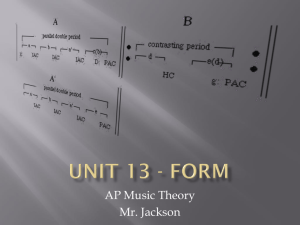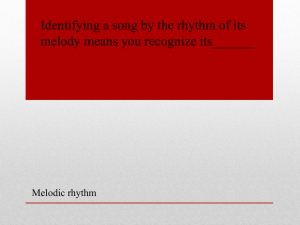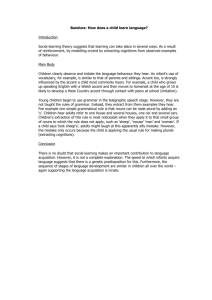APmusicVocab
advertisement
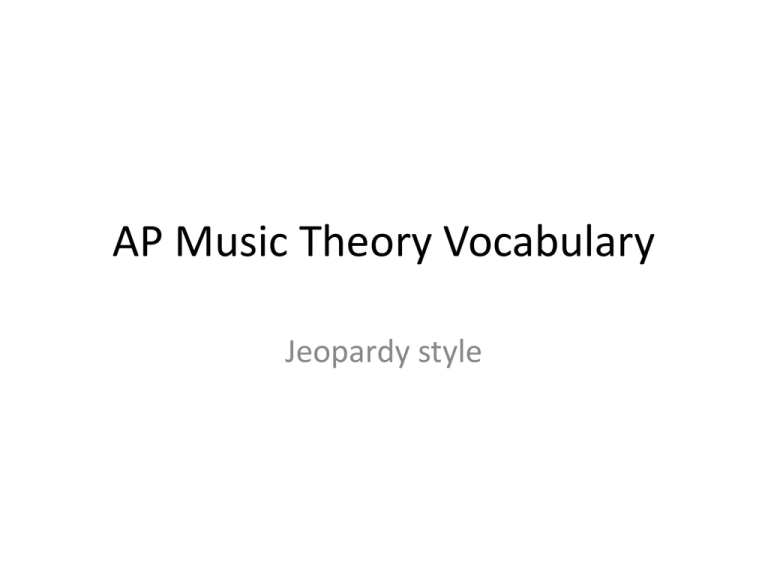
AP Music Theory Vocabulary Jeopardy style Musical textureall performers on same notes and rhythms without harmony monophonic (monophony) --unison/doubled at octave-- Musical texturemelody plus accompaniment can be chordal homophonic (homophony) Arpeggiation, Alberti Bass Musical texturechordal all voices move at the same time homorhythmic Musical textureall performers on same melody but add individual embellishments heterophonic (heterophony) --often Non-Western-- Musical texturemore that one independent line occurring at the same time polyphonic (polyphony) --imitative and non-imitative— fugue, canon can be contrapuntal Meternote value that gets 1 pulse in the music macrobeat Meternote value for the first level of subdivision microbeat (i.e. eighth note in 2/4 time) Metermacrobeat is divided into 2 equal parts simple 2/4, 2/2 Metermacrobeat is divided into 3 equal parts compound 6/8, 3/16 Meterregular grouping of macrobeats in two’s duple 2/4, 2/2 = simple duple 4/4 can be called quadruple 6/8= compound duple Metermacrobeats grouped in three’s triple 3/4 = simple triple 9/8 = compound triple Metercombinations of simple and compound macrobeats within the measure asymmetrical or irregular 5/4 (2+3 or 3+2), 7/8 Rhythmplacement of an accent where one would not normally occur syncopation Rhythman accent of length, rather than volume agogic accent perceived accent because this longer note is surrounded by faster notes or is deliberately lengthened by performer. (Viennese Waltz, Mazurka) Rhythman accent resulting from pattern of notes in the rhythm metrical accent (like in syncopation) also the ‘downbeat accent’ Rhythm‘pick up’ notes incomplete measure as the start of a phrase anacrusis Rhythmdoubling the note values augmentation Rhythmhalving the note values diminution Rhythmtwo groups of three beats are replaced by three groups of two beats. hemiola Rhythmin compound meter, group of 2 notes in the space of 3 duplet Rhythmin simple meter, group of 3 notes in the space of 2 triplet Rhythmin compound meter, group of 4 notes in the space of 3 quadruplet Rhythmin simple meter, group of 6 notes in the space of 2 sextuplet Rhythmmetric note groupings within the measure that are different from typical metric pattern cross rhythm (as in hemiola) 9/8 = 2+2+2+3 rather than 3+3+3 RhythmSimultaneous contrasting metric patterns polyrhythm Rhythmrhythmic feel when eighth note pairs feel like the outer notes of a triplet group swing rhythm Expressionan accent of length, rather than volume agogic accent perceived accent because this longer note is surrounded by faster notes or is deliberately lengthened by performer. (Viennese Waltz, Mazurka) Expressionan accent of volume, emphasis is created because one note is louder than the others dynamic accent Expressionan accent resulting from pattern of notes in the rhythm metrical accent (like in syncopation) also the ‘downbeat’ accent Harmonypoint at which a phrase comes to rest cadence HarmonyV – I or V-i authentic cadence Harmony-phrase ending V-I or V-i both chords in root position, soprano ends on tonic perfect authentic cadence (PAC) Harmony- - phrase ending V-I or V-i both chords in root position, soprano ends on 3rd or 5th imperfect authentic cadence (IAC) Harmony-phrase ending on V half cadence (semi cadence) Harmony-phrase ending IV – I or iv-i plagal cadence Harmony-phrase ending V-vi, V-ii (when V-vi, vi is in root position) deceptive cadence Harmony-phrase ending iv6 – V (in minor key only) [slow mvt. of Baroque concerti] phrygian half cadence Harmony-triad M3 & P5 above root (M3 plus m3) Major Harmony-triad m3 & P5 above root (m3 plus M3) minor Harmony-triad m3 & d5 above root (m3 plus m3) diminished Harmony-triad M3 & A5 above root (M3 plus M3) Augmented HarmonyMajor triad plus minor 7th Dominant 7th HarmonyMajor Triad plus Major 7th Major 7th Harmonyminor triad plus minor 7th minor 7th Harmonydiminished triad plus minor 7th ½ dim Ø m7♭5 th 7 Harmony4 notes, all minor thirds fully diminished 7th Harmony 6 4 cadential 6---5 4---3 Harmony 6 4 unaccented placement middle of passing tones in bass passing 6 4 Harmony 6 4 bass note stays same upper notes of harmony (root & 3rd) move by step & return pedal 6 4 Harmony-Progression up 2, down 3, up 4, down 5, up 6, down 7 except V or vii never goes to iii/III HarmonyCircle Progression roots move up 4 or down 5 HarmonyRetrogression (regression) roots move opposite rules of progression (i.e. ii-I) Harmonyrd Raised 3 on tonic chord at end of passage in minor key Picardy third HarmonyFull transcription of harmonies indicated by Figured Bass includes Roman numeral analysis realization Harmonythe prolongation or delay of a cadence by the addition of material beyond (i.e. before or after) the point at which the cadence is expected cadential extension (pre-cadential/postcadential) Harmonychord that sounds most stable (like ‘home’) tonic function Harmonychord(s) that sound like they are travelling or leading to dominant (vi, ii, iii) predominant function Harmonychord that leads to tonic (V, vii°) dominant function -Harmonic Errorcontradicting accidentals on same or adjacent beats false relation cross relation -Harmonic Featurestreatment of a new pitch so that it indicates a change of key tonicization Harmonypace at which harmonies change harmonic rhythm Non-Harmonic Tone (NCT) accented or unaccented connect notes to create stepwise melodic motion passing tone Non-Harmonic Tone (NCT) accented or unaccented move by step away from chord tone & back to same note by step neighbor tone (upper or lower) Non-Harmonic Tone (NCT) belongs to the next chord (usually in soprano) anticipation Non-Harmonic Tone (NCT) accented approach by skip, resolve by step (usually in soprano) appogiatura Non-Harmonic Tone (NCT) unaccented approach by step, depart by skip escape Non-Harmonic Tone (NCT) usually unaccented notes above & below chord tone (upper & lower neighbor – by step) double neighbor cambiata changing tones Non-Harmonic Tone (NCT) tone that remains the same even though upper harmonies are changing (as if you exclude bass from harmony) pedal tone (pedal point) [if in another voice, inverted pedal tone] Non-Harmonic Tone (NCT) accented held over from previous chord, resolves up by step retardation Non-Harmonic Tone (NCT) accented held over from previous chord resolves down by step suspension -Musical Stylescategory that identifies pieces of music as belonging to a shared tradition or set of conventions genre -Musical Styleselaborate accompanied song for solo voice from a cantata, opera, or oratorio aria -Musical Stylesvocal music composition, usually written for one voice with piano or orchestral accompaniment art song -Musical Stylescomposition featuring one or more solo instruments with orchestra, typically in three movements concerto -Musical Stylesextended composition in three or more movements for orchestra symphony -Musical Stylesinstrumental composition (especially of the 17th or 18th century) consisting of a succession of sections (dances) in the same or related keys suite -Musical Stylescomposition featuring one or more solo instruments with accompaniment (keyboard or continuo), typically in three movements sonata -Musical Stylescomposition for an orchestra and one or more solo instruments, typically in three movements (ripieno=tutti, concertino=soli) concerto grosso -Musical Styles‘rhythm section’ of the baroque bass line instrument like cello plus a chordal instrument like harpsichord, lute or guitar to realize the figured bass (basso) continuo thoroughbass -Musical Stylesimitative polyphony in which a theme or themes (subjects) are stated successively in all of the voices fugue -Musical Styleslarge scale theatrical musical work featuring singing and instrumental music to relate a story opera -Musical Styleslarge scale musical work featuring singing and instrumental music to relate a biblical story oratorio -Musical Styleslarge scale musical work featuring solo and ensemble singing and instrumental music based on a sacred text cantata -Musical Stylesstyle of singing in operas, oratorios, and cantatas in which the text is declaimed in the rhythm of natural speech with slight melodic variation and little orchestral accompaniment. recitative -Musical StylesA piece or movement that serves as an introduction, precedes a fugue, opens a suite, or precedes a church service; also a short piece for solo instrument in this style. prelude -Musical Stylesa final or concluding piece or movement postlude -Musical Stylesa sonata-like multi-movement composition for 2 violins, 1 viola, 1 cello string quartet -Form2 contrasting sections binary -Form2 contrasting sections, first section repeats ternary -Form2 contrasting sections, second section ends with material from first section rounded binary -Form3 contrasting sections First section repeats after each contrasting section rondo -FormMain melody repeats with different lyrics strophic (hymn style) -FormMain melody repeats with changes including rhythm, meter, mode, harmonization, embellishment Theme & Variations -FormMain melody repeats with changes including rhythm, meter, mode, harmonization, embellishment Theme & Variations -FormOpening section prior to first main theme introduction -Formending section Coda (tail) -FormAABA Jazz song form -Formtransitional section about 2/3 through song, usually in the IV key bridge -Formtransitional section of a composition interlude -Formsection of song with same lyrics each time (often contains the ‘hook’) chorus (refrain) -Formsection of sing with different lyrics for each repetition verse (stanza) -FormI I I I IV IV I I V IV I 12 bar blues -Formrepetition of main song (usually aaba) featuring whole ensemble, different combos and solos on each repetition. chorus format -Formsection ending that leads back to beginning of main melody (often V - - - with I at start of section) turnaround -Formmusical work lacking any repetition of thematic material through composed -Melodic Featuresdoubling note durations (or lengthening proportionally) augmentation -Melodic Featureshalving or shortening note durations proportionally diminution -Melodic Featuresstepwise melodic motion conjunct -Melodic Featuresmelodic motion by skips and leaps disjunct -Melodic Featureswhen the last note of one phrase serves as first note of next phrase (phrase) elision -Melodic Featuresreversal of melodic direction melodic inversion -Melodic Featuresin backwards order retrograde -Melodic Featuresdevelopment of melodic ideas motivic transformation -Melodic Featuresmelodic or rhythmic figure that recurs motive -Melodic Featuresrepetition of a melodic figure at successive pitch levels sequence -Melodic Featuresprecise repetition of a melodic figure at successive pitch levels (preserves all intervals & qualities) real sequence -Melodic Featuresrepetition of a melodic figure at successive pitch levels using only the tones of the prevailing scale tonal sequence -Melodic Featuresrepetition of a melodic figure at successive pitch levels with embellishments but retaining original character modified sequence -Melodic Featuresrepetition of a parts of a melodic figure and exact repetition of other parts of the melody false sequence -Melodic Featuresmusical unit formed by 2 (or more) adjacent phrases period -Melodic Featuresmusical unit formed by 2 (or more) adjacent phrases that begin in the same manner parallel period -Melodic Featuresmusical unit formed by 2 (or more) adjacent phrases that have different melodic content contrasting period -Melodic Featuresmusical unit formed by 4 (or more) adjacent phrases using repetition and contrasting melodic ideas (commonly aaba, abab, etc.) double period -Melodic Featuresmelodic elongation, often through repetition & sequences can be at beginning, middle or cadence phrase extension -Melodic Featuresclimax of phrase, (usually 2/3 through) focal point -Melodic Featuresfirst phrase of a musical period, with a complementary phrase following antecedent -Melodic Featuressecond phrase of a musical period that completes or answers the first phrase consequent -Melodic Featuresdeletion of end of phrase (opening motive is kept) truncation -Melodic Featuresadditional independent melody designed to fit with the principal melody countermelody -Melodic Featuresadditional melody, usually for a soloist including embellishment (not to be left out – can also indicate an accompaniment) obbligato
